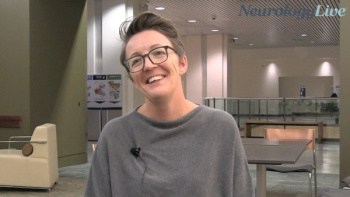
Highlighting the Benefits of a Virtual Wellness Platform for Patients With Parkinson Disease
Konstantin Karmazin, MD, clinical neurologist and chief medical officer of Prime PD, outlined the goals of the platform, as well as the variety of fitness programs offered for subscribers.
In light of the COVID-19 pandemic, the introduction of telehealth and telemedicine has aided in ensuring communication continues between patients and providers. This has also opened the door for additional virtual platforms to take shape, including Prime PD, a new digital wellness studio for patients with Parkinson disease (PD).
As research suggest the specific benefits exercise-based programs can have for quality of life in PD, fitness programs can be one avenue patients can pursue for disease-modifying benefits, as there is currently no medication that can provide for this relief. Prime PD unites the ability to exercise and the need for remote fitness programs, especially considering the impact PD disease progression can have on mobility and access to ‘brick-and-mortar’ facilities, such as gyms.
The chief medical officer of Prime PD, clinical neurologist Konstantin Karmazin, MD, conversed with NeurologyLive® on the goals of the platform, emphasizing the desire to work hand-in-hand with physicians to ensure the best care possible for patients with PD. Karmazin further outlined available programs, noting that patients do not need a prescription to subscribe and get started.
NeurologyLive®: Can you provide some background on Prime PD? What are the goals of the program?
Konstantin Karmazin, MD: Prime PD is a new company that we describe as a virtual wellness platform for patients with neurodegenerative diseases. We've chosen Parkinson disease as the first area where we're going to develop content. The reason we've done that is because—and hopefully, the community is familiar with it—but Parkinson, out of the neurological diseases, has a tremendous body of evidence for exercise-based programs, providing a ton of symptomatic benefit, as well as quality of life and disease-modifying benefits, which in Parkinson, in particular, is[something] that medications unfortunately don't offer right now. From our point of view, especially my point of view is a neurologist, it's something that we feel very strongly about, but because Parkinson is still a relatively rare condition, in spite of being very common, it's hard for folks to get access to really high-quality programs. Out of the million [patients with] Parkinson there are in the US, it's hard for any specific city or local area to really have a high-quality program for people to get consistent access to.
Our goal with prime PD was, especially in light of COVID, to give people a virtual option where they can get access to certified [fitness classes], and we happen to have award winning coaches that are trained in programs like Rock Steady Boxing, Dance for PD, Big and Loud Therapy, as well as some, what I'll call less evidence based, but still really important programs, like artistic expression for Parkinson, and more occupational therapy-type programs. Our general goal is to bring all those resources to our patients virtually. We know that your life and your radius with Parkinson, over time changes substantially, and we know that even if you're in the position where you found a really great gym, and you found the perfect program, in reality, unfortunately, there's a possibility you might not be able to access that physical brick-and-mortar gym as easily, 1, 2, or 3 years from now. We wish that was different, but being realistic, we know that you can bring your iPad or your computer anywhere you go, and so our goal with Prime PD is to essentially create a virtual program where we bring these options to patients, and they can bring us wherever they end up going. So, if you go on vacation, if you go to a nursing home, if you end up in the hospital, or you're doing rehab, anything like that, where appropriate, we like to follow.
Can you expand on the types of programs you are offering? Is Prime PD something patients can seek out on their own or does it require a prescription?
[The platform] is something that patients and physicians can seek out. Right now, it's a virtual fitness program, so it's not in the world of physical therapy, it's not something that needs to be prescribed. We're available through a subscription basis, and so you pay a certain amount of money per month, depending on how many classes you want to engage with. As a [patient with] Parkinson, you have a lot of options from evidence-based programs. Rock Steady Boxing, Dance for PD, Big and Loud are all examples [of programs] that we have and that we offer. That said, not everybody loves every one of those modalities, and, we know that with people being people, you'd like to have options rather than just being presented with one thing that you have to do every single time. Our goal is to give people a nice curriculum based on how interested they are, and our subscriptions essentially vary on how many classes you're taking per week. Those classes, like I said, vary across many different programs, so the goal is to not necessarily say, “Hey, you're going to be taking Rock Steady Boxing 5 times a week,” but it's more in the model of a pick and choose, where you come in—and right now you can go take a look at our schedule on
The second piece of that, more for the physician audience, is that part of our process, which we think makes us special, is that every patient gets a 1-on-1 monthly evaluation through our coaches. Given that our coaches are all certified in training and working with [patients with] Parkinson, when [patients] join the program, they have an evaluation where we say, “Hey, maybe you like to do boxing, but your issues are not actually the ones that will benefit from boxing. Let's talk to you about what your specific limitations are—balance, rigidity, speed, whatever they are—and obviously, different programs have different benefits.” We can help work both with your interests and with your symptoms, to say, “This is what we think is the best curriculum for you to pursue, here's where these classes are happening, X number of times per week.” It's a guided process, very similar to how if you were to send a patient to a brick-and-mortar gym, they would have an intake where somebody said,“Let me see you move around, these are the exercises that I think would be beneficial for you.” But what we also want to offer is options. Rather than just saying, “You have to do 1 modality every day,” we know that the more activity you're doing, the better, so if we can get you doing 2 different classes every day, that would be our goal.
The other piece of that is, we really want to work hand-in-hand with physicians, because a lot of the time, these clinically adjacent services like PT, like fitness, it's a little bit of a black box for the provider. I know for me, in my experience, even if you know the person you're sending [the patient] to, or you know the gym or the business is reputable and good, you have no idea what happens there, you have no idea how often people use it. What we're trying to bake into our system, from a technology point of view, is to let physicians, when interested and with their patient's approval, see their level of activity and the kind of programs that they're engaging in, to let us cue the physicians in. Hopefully that will give them a better sense of how their outcomes are going, and if they can modify or optimize anything like that. We want to work very closely with the physician community.
Are there plans to generate programs for other disease states in the future?
Right now, our focus very much as a new company—we just formally launched in January—we're very new, and we have a good subscriber base that's actively growing, but our main goal right now is to get our name out there to the physician community, most importantly. A lot of the time, everybody knows fitness is good in general, but there's been a lot of evidence, especially [in] an article published in JAMA Neurology last November, which showed the more exercise you do of higher intensity, the better outcomes you have, the [greater] longevity you have, and the less additional injuries you have from Parkinson. So, our goal is basically to work togetherto really max out that process and learn as much as we can while working with that [physician] community. We would like to then leverage, essentially, all our coaches who know how to work with patients who have either a neurocognitive issue or a motor issue—you might be in a wheelchair, you might have asymmetric mobility—we know how to work with that population, in terms of our coaching staff, how to be sensitive to that, which we feel is incredibly important. Once we figure out the logistics of running a virtual fitness company, using the best evidence that we have, which is we feel is in this Parkinson space, our goal after that is to move into more chronic conditions, with a focus on dementia, MCI, or mild cognitive impairment, as the biggest secondary target.
That said, we also know that in general, exercise is good for everybody, and the nervous system in particular really responds well. As evidence develops, hopefully over the next year or 2, we would be very open to MS [multiple sclerosis] exercise fitness programs and things like that. The other thing I'll say is, we know that there are also, in addition to fitness, other clinically adjacent and beneficial services that patients often seek out. I think nutrition is a perfect example that we would like to also bundle into this package. Often, your fitness goals are tied to your nutrition and are tied to your other health goals, and once we have the pathway and logistics worked out for the fitness offerings, we already have some plans to expand that within the Parkinsoncommunity to say, “We know that your doctor can't talk to you about everything, but we do want to be that trusted source of information that's going to work with your doctor to address as much as we can virtually.”
Transcript edited for clarity.
Newsletter
Keep your finger on the pulse of neurology—subscribe to NeurologyLive for expert interviews, new data, and breakthrough treatment updates.



































